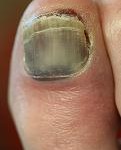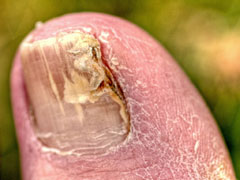| Before you can start thinking about which nail fungus cure to use for a given infection, it is most important to understand the symptoms and indications that an infection is present. There are many different signs that you may have contracted a nail or toenail fungus infection and below are descriptions and brief explanations of the most common.
Primary Symptoms and Indicators of a Nail Fungus Infection
- Often the earliest sign of the presence of nail fungus are a collection of small white dots just beneath the surface of the nail. These generally come in a group of 5-10 spots and are most often seen in the middle of a recently infected nail.
- The nail bed starts to lose its natural color in any way. This discoloration could come in the form of small, yellowish dots, a milky or “cloudy”
 look to the nail bed or a dark spot or tone to a corner of the infected nail. [The image on the right is of a big toenail that has already reached a very infected stage]. look to the nail bed or a dark spot or tone to a corner of the infected nail. [The image on the right is of a big toenail that has already reached a very infected stage].
- The nail bed begins to look wavy and loses the normal shape. Sometimes, a nail will begin to form ridges and lose the smooth, flat surface as fungal agents begin to attack the area beneath the nail bed.
- Thickness or brittleness of the nail. If the nail starts to lose it’s natural shape or get “crumbly”, that usually means the fungal agents are active and have already begun attacking the nail bed.
- Any odor or any unpleasant scent emanating from the infected nail or nails. This is a very strong indication of a toenail fungus infection and you should talk with a podiatrist as soon as possible.
Now, below is a description of the two most common types of toenail fungus infections:
1. The fungus starts at the ENDS of the nail and slowly raises the nail up.
 This is called distal subungal onychomycosis and is by far the most common type of fungal infection of the nails (90%). It usually starts as a discolored area at a corner of the big toe and slowly spreads toward the cuticle. This discoloration could be dark, “cloudy” or yellow. Eventually the toenail will become thickened and flaky. It is far more common in the toes than the fingers. This is called distal subungal onychomycosis and is by far the most common type of fungal infection of the nails (90%). It usually starts as a discolored area at a corner of the big toe and slowly spreads toward the cuticle. This discoloration could be dark, “cloudy” or yellow. Eventually the toenail will become thickened and flaky. It is far more common in the toes than the fingers.
High risk factors include older age, swimming, athlete’s foot, psoriasis, diabetes, family members with the infection, or a suppressed immune system. Sometimes, you can also see athlete’s foot in between the toes or skin peeling on the sole of the foot. If this skin fungus is present in and around the toes, the risk of contracting a toenail fungus infection skyrockets! It’s important to start treatment as close to this point as possible.
2. The fungus starts at the BASE of the nail and raises the nail up.
This is called proximal subungal onychomycosis and is a far less common type of fungal nail infections (3%). It is similar to the distal type, but it starts at the cuticle (base of the nail) and slowly spreads toward the nail tip. This type almost always occurs in people with a damaged immune system. It is also less difficult to spot because the discoloration is less obvious when closer to the cuticle.a
And PLEASE remember! One of the most important steps for eliminating a nail fungus infection is to attack the infection with a nail fungus cure as soon as it is detected!
|